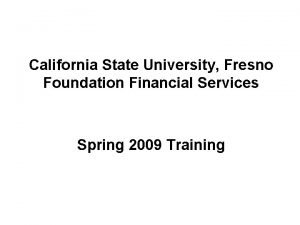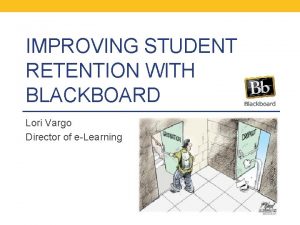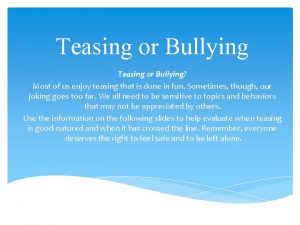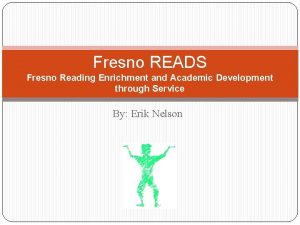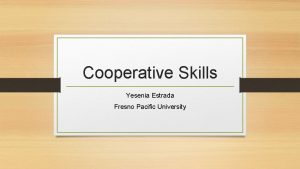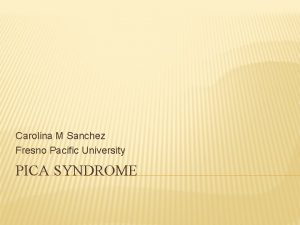TEASING LORI COOPER FRESNO PACIFIC UNIVERSITY TEASING IN



















- Slides: 19

TEASING LORI COOPER FRESNO PACIFIC UNIVERSITY

TEASING IN OUR SOCIETY OBJECTIVE WHAT IS TEASING TYPES OF TEASING REASONS FOR TEASING LEADS TO AGGRESSION NEEDS ASSESSMENT ON TEASING QUESTIONAIRE TEACHERS PERCEPTION HOW TO MANAGE TEASING CONCLUSION REFERENCES

TEASING “Refers to verbal or nonverbal exchanges between children or between a child an older person” (Marion, 2011, p. 305). This Photo by Unknown Author is licensed under CC BY-NC-ND

THREE TYPES OF TEASING • HURTFUL- identified as acts of physical aggression such as pinching and pulling away one’s chair, was found to be quite prominent in the earlier school age years • MEAN-Is calling others aversive names. Such names were typically associated with actual physical defects or disfigurement in the target of the teasing, which is found to be less prevalent in early school age children • SYMBOLIC TEASING- as the form of teasing associated with playful games, abstract thought processes, physical gestures and derision • Kostanski, M. , & Gullone, E. (2007)

REASONS FOR TEASING • AWKWARD WAY OF ESTABLISHING A FRIENDSHIP • REFLECTS HAVING LEARNED TEASING • LACK OF KNOWLEDGE OF DIFFERENCES • SENSE OF CONTROL • ROUTE TO PEER ACCEPTANCE • (MARION, M. , 2011, P. 306)

TEASING One group frequently taunted is overweight and obese youngsters. These children are teased by both children and adults” (Marion, 2011, p. 305). “ This Photo by Unknown Author is licensed under CC BY-NC-ND BY-SA

TEASING CAN RESULT IN VIOLENCE • “A child who is humiliated very often reacts to his angry feelings by striking back at the teaser” (Marion, 2011, p. 305).

LEVELS OF TEASING • According to Harwood and Copfer, a person’s background in teasing whether they were teased a lot as a child or not teased as a child effects how they respond to teasing (2011).

TEACHERS PERCEPTION “Teachers perceptions could impact their view of teasing how they differentiate between teasing and bullying, and the decision they make both proactive and reactive interventions” (Harwood, D. , & Copfer, s. , 2011, p. 76).

TEACHERS • “The five teachers of this study tended to rely on proactive strategies and conversation most often as a means to address teasing in the classroom” (Harwood, D. , & Copfer, s. , 2011, p. 84).

TEACHERS RESPONSE PROACTIVE CONVERSATION CONSULTATION (Harwood, D. , & Copfer, s. , 2011, p. 85). DIFFUSE VERBAL REPRIMAND

NEEDS ASSESSMENT QUESTIONNAIRE FOR PARENTS OF CHILDREN 4 -8 YEARS OLD • 1. IS YOUR CHILD GOOD AT TAKING ANOTHERS PERSPECTIVE? 30% YES • 2. DOES YOUR CHILD HAVE EMOTIONAL BREAKDOWNS? 50% YES • 3. DOES YOUR CHILD ACCEPT CHILDREN THAT ARE DIFFERENT FROM THEMSELVES? 100% YES • 4. DOES YOUR CHILD NEED TO BE IN CONTROL IN MOST SITUATIONS? 20% YES • 5. DOES YOUR CHILD RESPECT OTHER PEOPLE DIFFERENCES? 100% YES • 6. DOES YOUR CHILD STRIVE TO BE ACCEPTED BY PEERS? 70% YES • 7. DOES YOUR CHILD TEASE OTHER CHILDREN JUST FOR FUN? 20% YES • 8. DO YOU CONSIDER YOURSELF INVOLVED IN YOUR CHILD’S CHOICES? 100%YES • 9. DO YOU THINK TEASING IS AN ACCEPTABLE WAY TO PLAY? 60% YES

NORMAL TEASING • “It's a normal part of children's social relations even if the teased child appears to dislike it. But if it goes on too long, or if the child being teased seems to be getting upset, intervene” • (Greenberg, 2006, p. 29)

WAYS TO SUPPORT NEW BEHAVIORS • “DEALING WITH TEASING DEPENDS ON THE FUNTION SERVED BY TEASING AWKWARD WAYS OF ESTABLISHING FRIENDSHIP, HAVING LEARNED TEASING, LACK OF KNOWLEDGE OF DIFFERENCES, SENSE OF CONTROL, OR ROUTE TO PEER ACCEPTANCE” (MARION, 2011, p. 306).

HOW TO MANAGE TEASING ESTABLISHING FRIENDSHIP OR LACK OF SENSE OF CONTROL LEARNED KNOWLEDGE OF OR GAIN PEER TEASING DIFFERENCES ACCEPTANCE TEACH THE PLAYFUL TEASER ABOUT OTHER PEOPLES VIEWS ESTABLISH A CLEAR RULE OF NO TEASING FOLLOWED UP WITH HELPING CHILDREN BE IN CONTROL IN HEALTHY WAYS (MARION, 2011, P. 307) FOCUS ON UNDERSTANDING THAT WE ARE THE SAME BUT WE DO HAVE DIFFERENCES

POSITIVE BEHAVIOR SUPPORT • “When problem behaviors at school are the concern, Positive Behavior Support (PBS) is an approach that offers these three levels of prevention (see http: //pbis. org ). School wide discipline, at the primary prevention level, emphasizes teaching, prompting, and reinforcing appropriate behavior proactively and universally, to all children in the school “(Tobin, & Sugai, 2005 p. 125).

CONCLUSION • Teasing can start out as playful banter and turn quickly to hurting someone’s feeling. • Educators need to be able to understand their own perception on teasing in order to effectively guide children to the correct behavior. • The authoritative type of teaching is the best way to guide children properly in communicating with their peers. • Encouraging children learn to understand another child’s perspective. • Implementing school wide PSIS program as a means of prevention.

REFERENCES Greenberg, P. (2006). The Problem With Teasing. Scholastic Parent & Child, 13(4), 28 -31 Harwood, D. , & Copfer, S. (2011). Teasing in Schools: What Teachers have to Say. International Journal Of Interdisciplinary Social Sciences, 6(3), 75 - 91 Kostanski, M. , & Gullone, E. (2007). The Impact of Teasing on Children’s Body Image. Journal Of Child & Family Studies, 16(3), 307 -319. doi: 10. 1007/s 10826 -006 -9087 -0 Marion, M. (2011). Guidance of young children. (9 th ed). Boston MA: Pearson Tobin, T. J. , & Sugai, G. (2005). Preventing problem behaviors: Primary, secondary, and tertiary level prevention interventions for young children. Journal of Early and Intensive Behavior Intervention, 2(3), 125 -144. doi: 10. 1037/h 0100309

PRESENTATION EVALUATION • 1. DID THE PRESENTER SEEM KNOWLEDGEABLE ON THE SUBJECT? • 2. WAS THE PRESENTER FOCUSED ON THE TOPIC? • 3. WAS THE TOPIC COVERED THOROUGHLY? • 4. WAS THE PRESENTATION INFORMATIVE? • 5. DID THE PRESENTER TAKE QUESTION AND ANSWER THEM EFFECTIVELY? • 6. HOW WOULDS YOU RATE THE PRESENTER?
 Along came mr crocodile quiet as can be
Along came mr crocodile quiet as can be Find and talk to maximilian
Find and talk to maximilian California state university fresno foundation
California state university fresno foundation Asuza pacific university
Asuza pacific university Azusa pacific school of nursing
Azusa pacific school of nursing University mobility in asia and the pacific
University mobility in asia and the pacific Ritsumeikan asia pacific university notable alumni
Ritsumeikan asia pacific university notable alumni Pacific university dental hygiene
Pacific university dental hygiene Lori whitehead
Lori whitehead Lori k grimes hill afb
Lori k grimes hill afb Maximo everyplace
Maximo everyplace Tatiana krista hogan
Tatiana krista hogan Lori hanson dnr
Lori hanson dnr Blackboard uscb
Blackboard uscb Lori cabrera
Lori cabrera Lori stromness
Lori stromness Jody lori
Jody lori Lori raetzman
Lori raetzman Lori leiter
Lori leiter Lori marsh
Lori marsh


